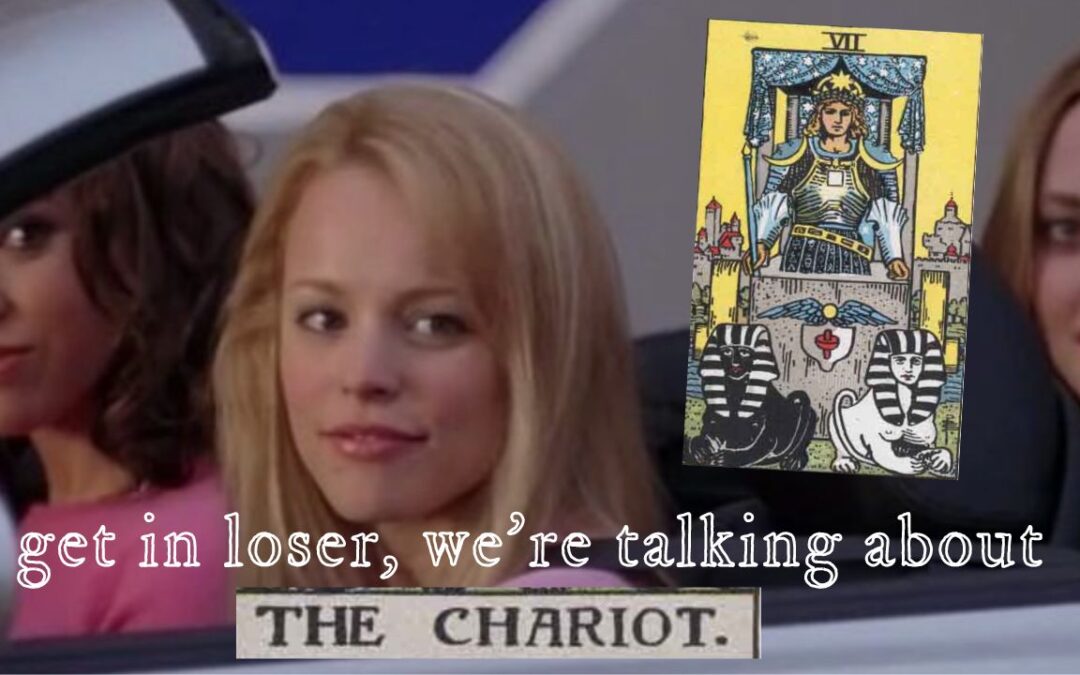Remember how back in January loads of tarot readers were sharing perspectives on the Chariot? Because according to the numerological method developed by Angeles Arrien, 2023 is a Chariot year (2+0+2+3 = 7, the Chariot). I’ve talked about this concept of collective year cards many times, so if you’ve been following me a while you might have heard this preamble: year cards aren’t something I’m super into. Numerology isn’t something I’m super into.
BUT- here’s something I love about tarot: if you’re open, you can find a way to powerfully and potently relate any card to any situation. So even if there isn’t some synchronistic mystical power connecting the Chariot and the year 2023, we can certainly find ways that this card is perfectly suited to this moment in time.
I said I was going to chime about the Chariot back in January but haven’t yet, oops. It’s October and I’m fashionably late but there’s still time so LET’S GO.
Part One: Origins + Evolution of the Chariot
My last piece focused on tarot history, and it so happens that the Chariot says more about tarot history than perhaps any other card in the deck.
The oldest surviving versions were titled ‘Il Carro Triumphale’ or the Triumphal Chariot. ‘Triumphs’ were a sort of parade, originating in ancient Rome and re-popularized during the Middle Ages and Renaissance. In Rome, this was a show of military strength and hierarchy. The triumphs were led by prisoners, then would come the captors and ultimately the generals. The Renaissance versions were less military focused and more about general pageantry and celebration, drawing upon various cultural and religious elements. In the booklet accompanying the Golden Tarot, a re-creation of the Visconti-Sforza deck, Mary Packard writes:
Gleaming horse-drawn chariots filled with well-known heroic and villainous figures were accompanied by singers, dancers, and performance artists…. sometimes, Renaissance triumphs featured performers who embodied Plato’s virtues. Uniting the basic hierarchical form of the triumph with themes that were complex and allegorical in nature, these pageants presented a procession of virtues, each triumphing the other in importance.
Triumphs would have been familiar to the general public at the time the earliest tarot decks appeared and the Chariot card in particular – and perhaps even the entire major arcana – seems to be a nod to this. As we did last week, it’s time to once again shoutout to tarot historian Gertrude Moakley who was the first to point out many of these connections.
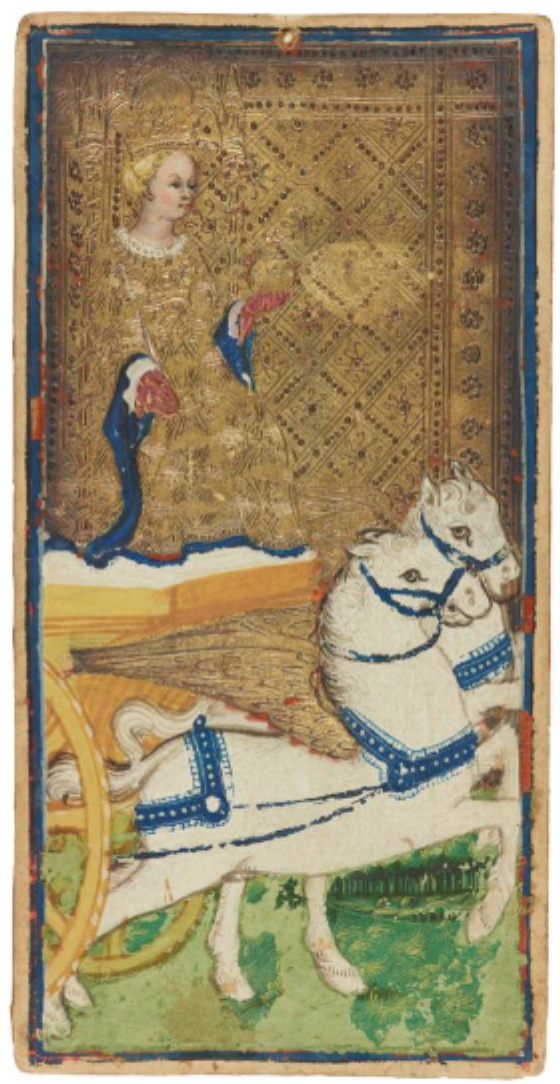
The Chariot card from the Visconti-Sforza
The Visconti-Sforza tarot was commissioned as a wedding gift for Bianca Maria Visconti, the daughter of a Duke, and Francesco Sforza, a military leader/mercenary. Of course this was a strategic marriage, orchestrated to increase the status of both families. Soooo yeah, one of the earliest tarot decks has its roots in hierarchy and imperialism.
Some tarot historians (starting with Gertrude Moakley) believe this original Chariot card shows Bianca Maria herself, but she seems to be taking on the role of Laura, the woman who inspired Petrarch’s famous poems I Trionfi. Mary Packard writes:
“As driver of the chariot, Laura displays multiple symbols of authority, including the golden crown on her head, the scepter carried in one hand, and the imperial globe held in the other. Enacting the Neoplatonic quest for immortality, Laura manifests as archetype for the hero. She must exert her will over the winged horses – one of which represents the Soul of Appetite and the other, the Soul of Will – as she guides the entire chariot/soul toward enlightenment.”
It’s difficult to see the scepter and globe in the above image as they’ve faded some from the originals, but they are visible in versions of the deck that have been restored.
I guess we need to talk about Plato a bit more. In Phaedrus Plato compares the soul to a Chariot with a driver and two winged horses, the same metaphor referenced by Packard above. A dark horse to represent the Soul of Appetite (or desire), the “lowest” part of the soul. A light horse to represent the Soul of Will (or Spirit). And the Charioteer represents the Soul of Reason, the “highest” aspect of the soul who directs the others. As we talked about last week, Plato’s work was trending during the Renaissance and does seem to have crept its way into the tarot.
It was 19th century occultist Levi who transformed the horses from earlier decks into sphinxes; the Waite-Smith tarot shows sphinxes as well. This was an attempt to highlight the supposed Egyptian origins of the tarot that early occultists proclaimed. It’s also interesting to me that the earliest cards showed a female Charioteer, some of the Marseille variations appeared gender nuetral (imho), but by the time Levi and Waite created their versions the Charioteer becomes male.
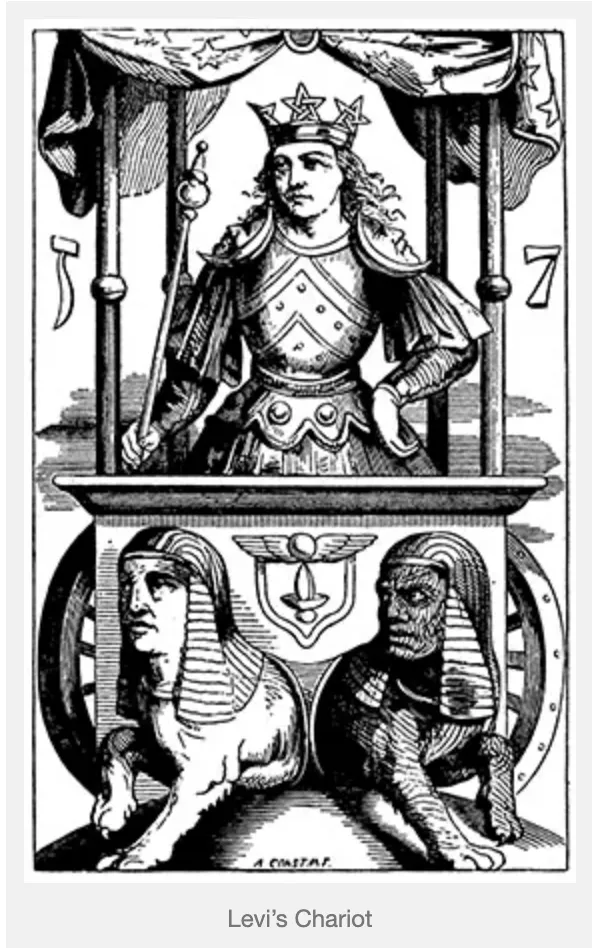
Image via robertmplacetarot.com
I’m currently reading Mystical Origins of the Tarot by Paul Huson which I bought because Rachel Pollack references it often in Tarot Wisdom. Most notably, Huson tracks the way the interpretations of cards evolved from the earliest occultists through Waite and the Golden Dawn. These interpretations don’t always line up with what we now know about the actual history of the card, because the occultists were not interested in (or even aware of) the Renaissance origin of the tarot and had their own fanciful theories about the cards.
Per Huson, Court de Gébelin described the Chariot as “Osiris triumphant.” Paul Christian continued this line of thinking, interpreting it as “the Chariot of Osiris, victory, a war chariot, an armed conqueror….the two sphinxes symbolize Good and Evil, one conquered, the other vanquished, both having become the servants of the Magus.”
In the Pictorial Key to the Tarot, Waite writes:
“He is above all things triumph in the mind. It is to be understood for this reason that (the Chariot) is concerned with a mystery of nature and not of the world of Grace, to which the charioteer could offer no answer. The planes of his conquest… are external and not within himself…the initiation he has passed in triumph is to be understood physically or rationally…if he came to the pillars of the temple of the High Priestess he could not open the scroll, nor if she questioned him could he answer.”
I think we see some of Waite’s ideas reflected in more modern interpretations, in many ways I think Rachel Pollack expands these thoughts in 78 Degrees of Wisdom. This was one of the first books I read on tarot and it has been instrumental in my understanding of this card. Rachel says:
“When we look at the cards sequentially we see 7 is only the victory of the first line of the Major Arcana. It crown’s that line’s process of maturation, but by necessity it cannot address the great areas of the unconscious and super-conscious. Seen this way the Chariot shows us the developed ego…the mature adult successful in life…able to control feelings, and above all, to direct the will.”
I can’t find the exact passage right now, but I believe it was also Rachel Pollack who pointed out that some people never move past the Chariot-level of development. Many commentators have compared the Chariot to Carl Jung’s concept of the persona – the curated ‘mask’ a person shows to the world. There is, of course, nothing wrong with developing a persona. In fact, it is essential to existing in this world. But in Rachel Pollack’s view of the three rows of the minor arcana, the second and third delve more into the nuances of the inner realms, as well as cosmological universal forces. Some venture there, some prefer the allure of stable identity and success represented by the Chariot.
Part Two: The Chariot & Me
Now that I’ve shared some historical context, I will divulge more about what the card means to me.
My intro to tarot was Learn the Tarot by Joan Bunning and there’s a specific angle she takes with the Chariot that has stuck with me all these years. Bunning uses the phrase “hard control” to describe this card. She views The Chariot as forming a pair with Strength, which is a “soft control.” There are other cards in the major arcana that are commonly seen as a pair (like the Magician/High Priestess, Emperor/Empress, Sun/Moon) but Chariot/Strength is not one you see all the time. I think this is a useful way to consider the cards, though.
At its worst, this “hard control” harkens back to some of the early influences of military conquest and hierarchy. Sometimes the Chariot is about making shit happen no matter what (or whom) gets trampled along the way. Whereas Strength is about patiently wrangling with something instead of forcing it into submission. As Bunning puts it, “there are many types of wins; the Chariot’s is of the win-lose type.”
Bunning also talks about will power as a key concept to this card. As someone who often feels scatterbrained and unfocused, this is an aspect of the Chariot that beckons me. I think about how much easier life would be if I was able to focus. If I could make decisions and move singularly towards them. If I had a concrete idea of who I was and what I wanted and moved pointedly in that direction.
As with any card, there’s a spectrum of potential (term borrowed from Arthur Rosengarten) in the Chariot. I try to avoid over-simplifying this as ‘positive and negative’ but there are ways that Chariot energy can be beneficial, and ways that it can be harmful. Chariot energy can inspire a healthy sense of identity and usher you forward to accomplish meaningful things. Or it can turn you into Ayn Rand.
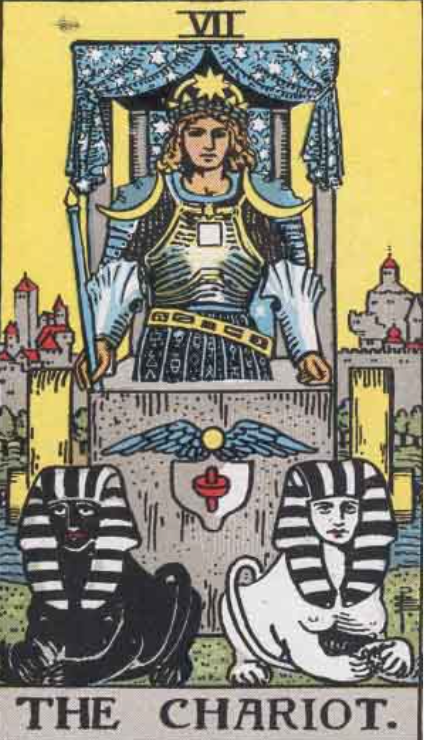
The Waite-Smith is the deck I started out with, and while I’m not going to break down every symbol here I wanted to mention what stood out to me the most as I learned tarot. That is the black and white spinxes, and how they seem to be going in different directions. Beyond the Platonic interpretations mentioned above, it’s always spoke to me of the necessity of managing any number of conflicting factors. Like… your practicality establishes one direction, but your passion veers you off course. Somehow you as the Charioteer need to navigate all this paradox to chart a singular course.
In writing this post, I’ve taken on the dreaded task of revisiting some of my old writings (fun fact about me: I want to disappear into a black hole every time I re-read something I wrote). I still quite resonate with how I wrote about the Chariot for my Wild Unknown blog series back in 2014:
I like to think of the Major Arcana as three sets of seven cards (with the addition of the Fool). In this view, the Chariot is the last card in the first row. In some ways, this card reminds me of a young adult, someone who has certainly matured but may have a narrow view of their overall growth. The Chariot speaks to a dogged determination to go in a certain direction, but on the shadow side Chariot energy can sometimes become TOO pushy and forceful…
There are many cards that speak of ease and flow, but the Chariot shows a counterbalance to these concepts. The Chariot is about determination, hard work and grit. In a metaphoric sense, you are a charioteer and the chariot you drive is your life. You have a responsibility to assert your control over that chariot and to take ownership over the direction you are headed.
The Chariot draws your attention to you and your path. This is a common theme in the visual presentation of this card in various decks. This card asks you to stay in your lane, to be aware of what YOU are doing. A shadow side of this can be selfishness and inflexibility. But at its best, Chariot energy brings you in touch with your most powerful autonomy.
There’s still something appealing about all of this to me, especially this idea of having SOME ability to direct your own life. Sometimes the external world and my own goddamn brain are so chaotic that I feel like I’m just being pulled along on the ride.
And maybe I am. The actual sphere of control for most of us is pretty small (and obviously varies depending on our unique privileges or lack thereof). I acknowledge that. But the Chariot is a reminder that there are some ways you can take the reigns, if you chose to do so. It reminds me of a quote I came across many years ago but can’t find the exact source: “I want to walk through life, not be dragged through it.”
When I finished writing this section I took a break and opened Instagram (as one does). The top post in my feed was from Chani Nicholas and this line got me: “all systems of supremacy bank on us forgetting how powerful we are! May we reclaim our agency!” This perfectly encapsulates what I’m trying to say here, and it brings us full circle from the card’s origins in conquering, into a more modern take on the Chariot’s potential to recalibrate our autonomy.
When creating the concept for the Spacious Tarot, I attempted to convey how the energy of the Chariot feels to me instead of relying on traditional imagery. So we ended up with something pretty different from the Waite-Smith or any of the earlier decks for that matter.
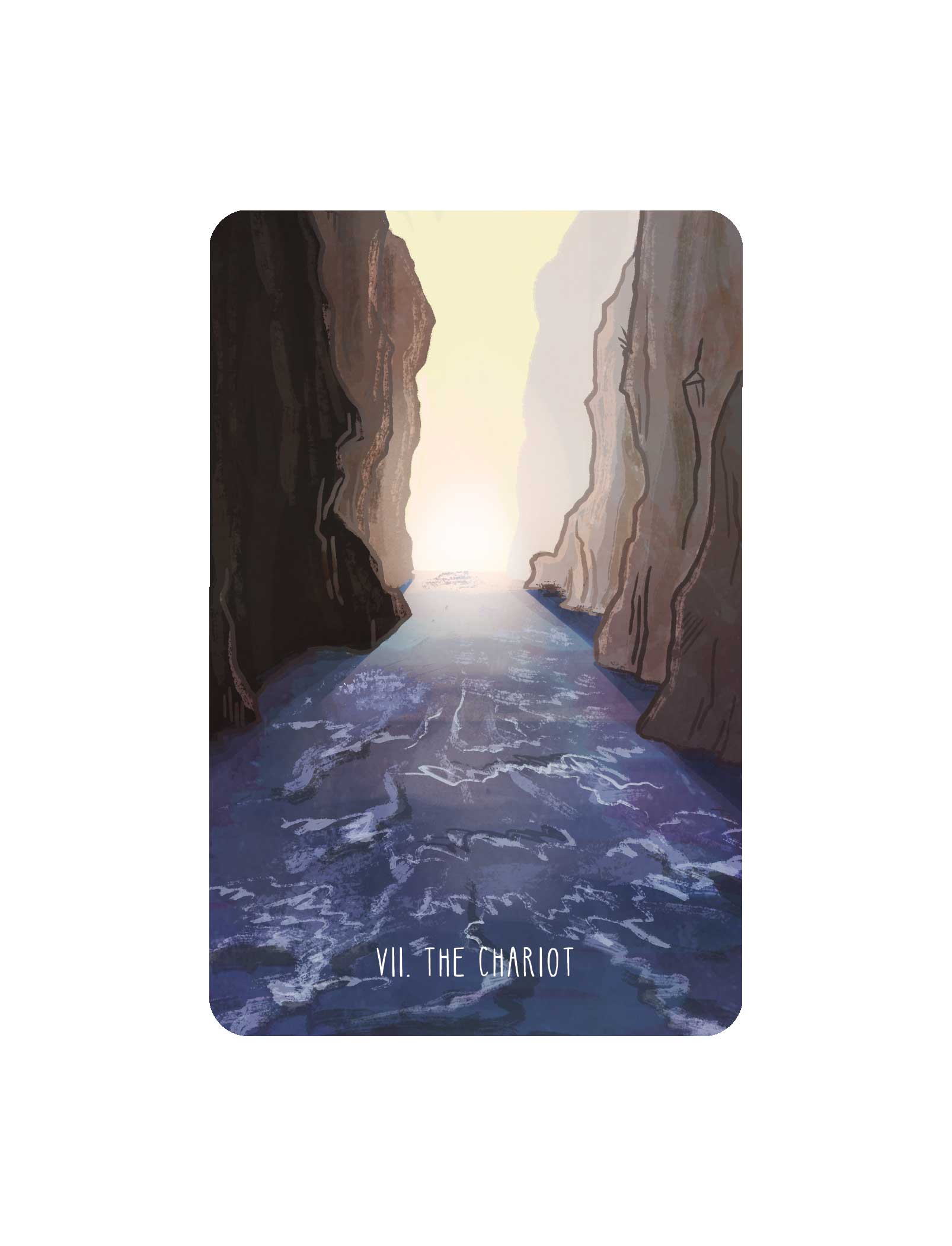
One time I was wading near the edge of the Colorado River and stepped in a little too far. The current grabbed me and I panicked for a moment because I could not fight against it. I managed to grab a tree branch and pull myself out before I got swept away, but I’ve never forgotten that sensation. It’s part of why this imagery came to me. I picture the determination it takes to press forward against a (metaphorical or literal) current and move towards the light on the horizon. And the power of something as simple as water to carve rocks and canyon walls.
This was more of a synchronicity than something intentional, but I like that we ended up with water in our version. The Chariot relates to Cancer in the astrological system used by the Golden Dawn. This has always been odd to me as I am a Cancer Sun and I see very little overlap in the zodiac sign and the tarot card. It’s one of the reasons I only toy with linking tarot to astrology and have never made it a pillar of my practice. Nonetheless, Cancer is a water sign and it pleases me that we have water in our depiction of the Chariot.
With the first person perspective we emphasized that the Chariot is about forward movement. I have a tendency to get moored in nostalgia and over analyzing the past. Sometimes that’s okay. But the Chariot echoes the expression “don’t look backwards, you’re not going that way.” ONWARD!
Part 3: The Year of the Chariot, 2023
I have the benefit of hindsight since I’m writing this closer to the end of 2023, but have been jotting down some notes for this post throughout the year.
Before we go further here, I want to tell you that I’m not going to be talking directly about the violence in Palestine in this post. I’m giving what I can to Doctors Without Borders and I echo what Chani Nicholas went on to say in the post referenced above: cease fire now. This horror intensified after I’d outlined much of this, and I believe it would be in poor taste to focus on it in the context of this post.
I wrote this sentence down at the beginning of 2023 when thinking about themes the Chariot might present this year: “identity, when to reaffirm vs when to soften out of it, moving beyond what your ego is comfy with.”
This has certainly been applicable for me this year. There’s parts of my identity I’ve been consciously trying to strengthen, like: I identify as a writer. A tarot practitioner. Solidifying that thru starting this Substack. Meanwhile, there are other parts of my identity I’ve loosened my grip on.
Some journaling prompts you could try for yourself: how has my identify shifted in 2023? What do I identify more with? What do I identify less with?
Earlier in the year I listened to an interview with Jarod K Anderson and he said something that connected some of the Chariot + 2023 themes for me:
“A lot of people who I feel like are not wrong, are calling for various kinds of revolution and deconstruction. And I don’t think that’s wrong. But I also think that if your thing is, say, industrialization of farming, and food production, and all of the consequences of it, I want to know more about how you feed everyone than how you destroy the industrialized farms. I just kind of feel like those insidious fingers of our cultural narratives, sneak in to even our well-meaning narratives of progress, because the destroyer is romanticized and the healer, and the grower, and the caregiver is not in so many of the dominant narratives.”
The bold part is what got me: the destroyer is romanticized. In fact, it reminded me of the origins of the Chariot, the Roman generals being celebrated for killing and imprisoning. That could be something to examine personally + collectively this year.
Who are the destroyers you’re romanticizing in your personal consciousness? And who/what are the destroyers we collectively romanticize? How can we direct our focus more towards solutions + healing? How can we keep shifting towards where we want to go instead of obsessing over the obstacles to that path?
A few months ago there was a sound trending on TikTok of Elyse Meyers saying “I don’t think there’s anything I couldn’t do at least half decently. I was born with the ‘how hard could it be’ gene, which is incredibly helpful and very delusional. It’s made me pretty lucky.”
This is total Chariot vibes, and as someone who was NOT born with this gene I want in on it. Since the Chariot is also about willpower, I suppose it’s fair to say I’ve been trying to will myself to develop this gene (moreso the helpful parts than the delusional parts). This harkens back to the ONWARD themes, the light on the horizon. How hard could it be to get there?
2023 has been a very difficult year for me personally, and the Chariot has been relevant in the way I’ve tried to just…keep going. Check my silly little emails. Go on my silly little mental health walks. Make incredibly simple to do lists just to feel like I’ve accomplished something. The Chariot isn’t always big and bold. Sometimes it’s just taking the next small action even when life seems completely overwhelming.
Well my friends, there’s always more to say but this seems like as good of a place to close things out as any. Thanks for takin’ a ride in the Chariot with me. I am sending you the very best wishes as we continue to move forward, forward, forward. Talk to you again soon.
Carrie

